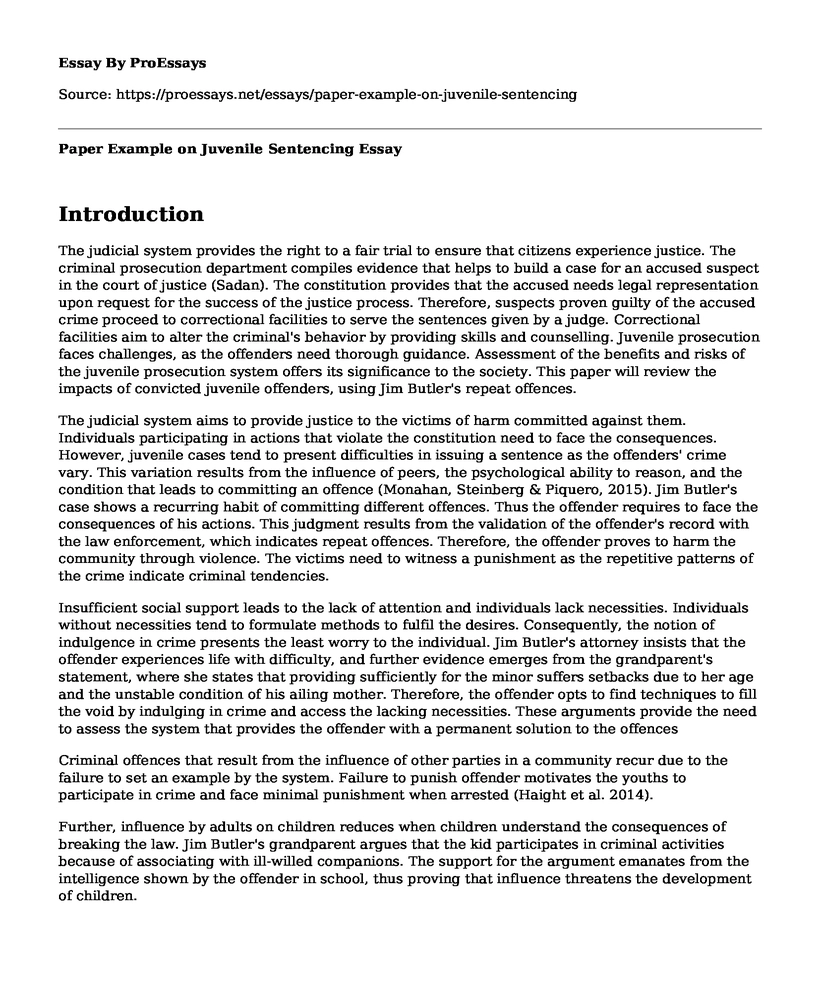Introduction
The judicial system provides the right to a fair trial to ensure that citizens experience justice. The criminal prosecution department compiles evidence that helps to build a case for an accused suspect in the court of justice (Sadan). The constitution provides that the accused needs legal representation upon request for the success of the justice process. Therefore, suspects proven guilty of the accused crime proceed to correctional facilities to serve the sentences given by a judge. Correctional facilities aim to alter the criminal's behavior by providing skills and counselling. Juvenile prosecution faces challenges, as the offenders need thorough guidance. Assessment of the benefits and risks of the juvenile prosecution system offers its significance to the society. This paper will review the impacts of convicted juvenile offenders, using Jim Butler's repeat offences.
The judicial system aims to provide justice to the victims of harm committed against them. Individuals participating in actions that violate the constitution need to face the consequences. However, juvenile cases tend to present difficulties in issuing a sentence as the offenders' crime vary. This variation results from the influence of peers, the psychological ability to reason, and the condition that leads to committing an offence (Monahan, Steinberg & Piquero, 2015). Jim Butler's case shows a recurring habit of committing different offences. Thus the offender requires to face the consequences of his actions. This judgment results from the validation of the offender's record with the law enforcement, which indicates repeat offences. Therefore, the offender proves to harm the community through violence. The victims need to witness a punishment as the repetitive patterns of the crime indicate criminal tendencies.
Insufficient social support leads to the lack of attention and individuals lack necessities. Individuals without necessities tend to formulate methods to fulfil the desires. Consequently, the notion of indulgence in crime presents the least worry to the individual. Jim Butler's attorney insists that the offender experiences life with difficulty, and further evidence emerges from the grandparent's statement, where she states that providing sufficiently for the minor suffers setbacks due to her age and the unstable condition of his ailing mother. Therefore, the offender opts to find techniques to fill the void by indulging in crime and access the lacking necessities. These arguments provide the need to assess the system that provides the offender with a permanent solution to the offences
Criminal offences that result from the influence of other parties in a community recur due to the failure to set an example by the system. Failure to punish offender motivates the youths to participate in crime and face minimal punishment when arrested (Haight et al. 2014).
Further, influence by adults on children reduces when children understand the consequences of breaking the law. Jim Butler's grandparent argues that the kid participates in criminal activities because of associating with ill-willed companions. The support for the argument emanates from the intelligence shown by the offender in school, thus proving that influence threatens the development of children.
Conclusion
The function of the judicial system to interpret the law leads to the punishment of lawbreakers. However, the evaluation of an offence based on the age of the offender and circumstances help to provide an understanding of the motive to participate in the crime (Dowse et al. 2014). Jim butler's case for the armed robbery needs the judicial system to help the offender grow into an upstanding citizen. Therefore, the offender should enrol in an intermediate program, such as the community-based facility. Juvenile prosecution aims to reform the offender. Thus an intermediate program facilitates the needs of the offender and reduces the possibility of breaking the law while supporting the access to his usual education program.
References
Dowse, L., Cumming, T. M., Strnadova, I., Lee, J. S., & Trofimovs, J. (2014). Young people with complex needs in the criminal justice system. Research and practice in intellectual and developmental disabilities, 1(2), 174-185.
Haight, W. L., Bidwell, L. N., Marshall, J. M., & Khatiwoda, P. (2014). Implementing the Crossover Youth Practice Model in diverse contexts: Child welfare and juvenile justice professionals' experiences of multisystem collaborations. Children and youth services review, 39, 91-100.
Monahan, K., Steinberg, L., & Piquero, A. R. (2015). Juvenile justice policy and practice: A developmental perspective. Crime and justice, 44(1), 577-619.
SADAN, N. JUVENILE JUSTICE SYSTEM. Training, 27, 1.
Cite this page
Paper Example on Juvenile Sentencing. (2022, Aug 15). Retrieved from https://proessays.net/essays/paper-example-on-juvenile-sentencing
If you are the original author of this essay and no longer wish to have it published on the ProEssays website, please click below to request its removal:
- "Letter from Birmingham Jail" By Martin Luther King: Critical Essay
- The Affordable Care Act: Impacts on Nursing Practice
- Reporters and Testifying in Criminal Cases: The Paul Branzburg Case Study
- Data Security and Privacy Protection in Cloud Computing - Research Paper
- Essay Sample on Exploring the Causes of a Litigation Explosion in the Courts
- Essay Example on Correctional System: Management, Handling & Psychology
- Essay Example on Intellectual Property Law: Protecting and Encouraging Innovation







